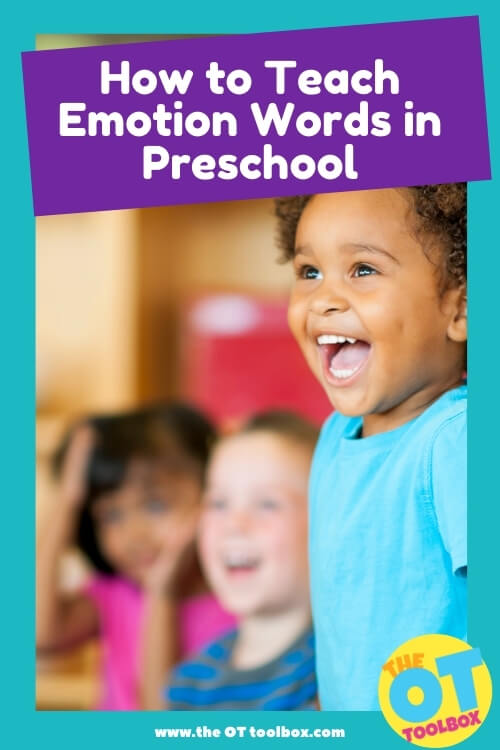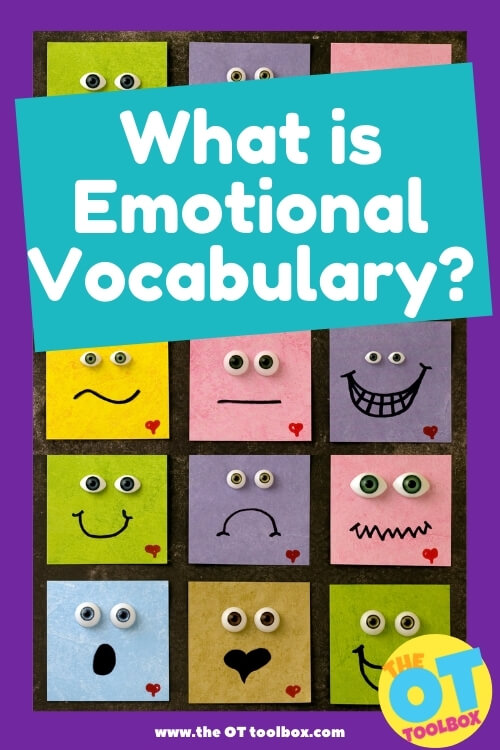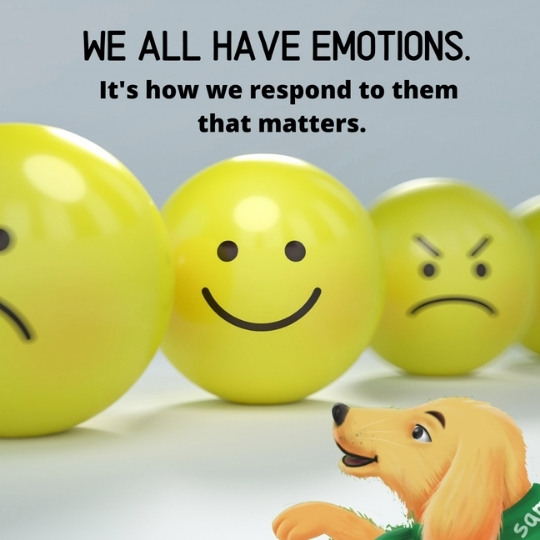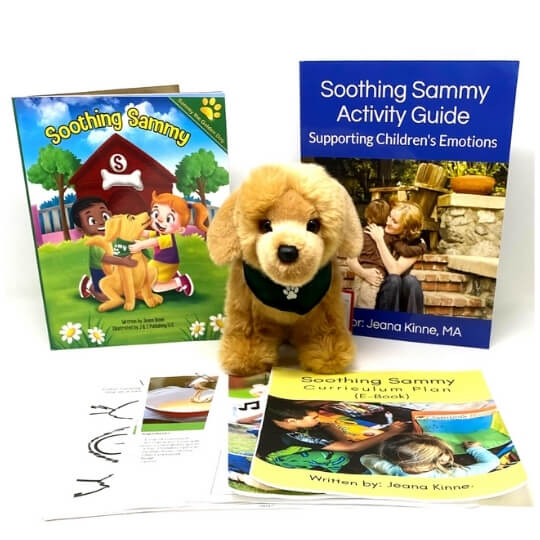It can be a challenge to teach develop emotional vocabulary in children and teaching emotion words to preschoolers. In this blog post, you’ll find out how our bodies react to our emotions in threatening situations, how to teach the most common emotion words to preschoolers and strategies to help young children understand emotions by giving them tools to support their emotional development.
Oh no! There Suzy goes again. She’s crying and I don’t know why. She seems hurt. Or maybe she’s nervous. Or is she sensitive to the classroom surroundings. Is she irritated or annoyed? All I did was hand her the red cup of water. I wish she knew the emotion words to communicate so I knew what the problem is.

What is Emotional Vocabulary?
Do you ever find yourself confused to why your child is screaming?
Did you know that there are over 34,000 different emotions?
Dr. Robert Plutchik was able to create an emotion wheel that categorized emotional vocabulary into these 8 areas, making a comprehensive list of emotions.
- Joy
- Sadness
- Trust
- Disgust
- Fear
- Anger
- Anticipation
- Surprise
If there are over 34,000 emotions, you can imagine how children with only 300-600 words may feel when trying to communicate them.
Tantrums and meltdowns usually occur because children don’t have the emotional vocabulary to communicate their emotions in a way that others would understand. There may be a component of personal experiences or an affective states that impacts how a child expresses their feelings in a given situation.
Think back to Suzy from the beginning of this blog. It turned out she was scared of the blender noise making the smoothie that was going to fill her red cup. In the moment of irritation/tenseness, she was too scared to remember the words she needed, so she started screaming instead. She didn’t know the emotions words to tell me the problem.

Why is Emotional Vocabulary Important?
And, why is it so hard for children to use emotion words to communicate while they are upset?
It is very difficult for young children to express words that they are feeling.
Emotional vocabulary like feeling impatient, helpless, uneasiness, hopelessness, nervousness, anxious feelings, fury, or apprehensive feelings contain a lot of meaning that aren’t part of the preschooler’s vocabulary just yet. Negative emotions that “take over” a situation in the way of a tantrum, breakdown, or other behavior can impact mood, learning, and personal relationships.
Similarly, positive emotions such as feelings of happiness, optimism, excitement, and euphoric behaviors can result in difficulty paying attention, silliness that interferes with learning or safety, or other strains on self-regulation.
Those are feelings that we definitely see expressed in the child’s body language, facial expressions, and behavior!
When a child has words to express their emotions, they develop resilience. They improve emotional literacy so that they can verbally express how they are feeling. Children move from feeling misunderstood to feeling certain of their situation.
And, when we understand components of emotion, we can help a child develop their emotional literacy by giving them words that they can recall and use even in the heat of the moment.
Developing emotional skills by building a library of emotion terms also helps children to navigate social environments in the school, home, classroom, and community. This emotional competence carries over with experience and practice in using and understanding emotional terms, especially in the thick of big feelings. Having words for the feelings children feel fosters positive interactions with others. Improving emotional vocabulary even impacts physical health. A robust emotional vocabulary comes with time and practice, but developing experience helps in so many ways.
All of this is related to emotional competence!

Emotional Literacy
On January 15, 2021, Carolyn MacCann Ph.D., Psychology Today explained psychology Professor James Gross’ four components of feeling an emotions and Professor Klaus Scherre’s process model of emotions. She states:
“Having emotions is a universal experience, and every person in the world has felt angry, shy, scared, or embarrassed at some point in their lives. According to psychology Professor James Gross, there are four components of feeling and emotion:
- The situation you are in (whatever is happening to you at that moment)
- The details you pay attention to
- Your appraisal of what the situation means for you personally
- Your response, including the physical changes (like blushing or shaking), and your behaviors (like shouting or crying).”
She goes on to explain Professor Klaus Scherer’s component-process model of emotion that includes the following 5 components to emotions:
- Feelings (subjective feelings, like “I feel scared”)
- Appraisals (though patterns, like “I am under threat”)
- Expressions (facial and bodily expressions of emotions, like being wide-eyed with fright)
- Action tendencies (the tenancy to prefer certain actions like freezing or hiding); and
- Physical changes (physical symptoms of emotion, such as butterflies in the stomach).”
Imagine what a small child must be feeling as they interpret the situation around them, processing what they are physically experiencing and trying to come up with a solution to the situation – all at the same time! Let’s look at Suzy, the little girl who is afraid of the blender.
Using Professor James Gross’s four components of feeling and emotion, she is likely feeling the following:
- The situation you are in – mom just handed me a red cup but I can’t hear what she is saying because there is a loud, grumbling sound coming from the counter.
- The details you pay attention to – I hear chopping and grumbling sounds that are deep and scary.
- Your appraisal of what the situation means for you personally – The blender is so loud that I can’t hear mom talking, or even hear myself telling her to stop.
- Your response, including the physical changes – I feel my heart beating faster, my hands are shaking a little and I’m closing my eyes because all my senses are on overload. Nothing is helping so I scream and cry, hoping mom will turn the blender off.
Now let’s look at Professor Klaus Scherer 5 emotional components as Suzie processes her emotions:
- Feelings – I am scared.
- Appraisals – I am in danger. My mom is in danger.
- Expressions – I’m closing my eyes really hard and have my hands over my ears.
- Action tendencies – I’m screaming because mom can’t hear me.
- Physical changes – I feel my heart beating faster, my hands are shaking a little and I’m closing my eyes because all my senses are on overload.
Wow! How do you feel after experiencing first hand what Suzy is experiencing? If only she would tug on mom’s shirt and say “turn off the blender, I’m scared of the loud noise.”
What Can You Do to Increase Children’s Emotional Vocabulary?
Adults have had years of experience processing their emotions and learning how to communicate them, but children need help. Learning emotion words is how preschoolers can reach out to us for help.
Activities that teach emotional vocabulary and specific emotion words to young children in a way that they understand and remember, will make it easier for them to recall the correct words to use to describe their feelings, even when they are in a stressful situation. Emotion word lessons are best taught through an active approach. Here are five fun ways to teach emotion words to preschoolers.
These are hands-on, multisensory activities to support emotional development in young children. They are tools for Developing and Using Emotional Vocabulary. They are fun ways to develop personal experience in developing emotional vocab!
Fun Ways to Teach Emotion Words to Preschoolers
1.Practice emotional vocabulary with Emotion face paper plates!
Tackle those fine motor skills while teaching emotion words. Understanding the facial expressions that match feelings help children identify and describe how others are feeling, so they know how to respond.
Using play based crafts, like paper plates, will reinforce how different expressions mean different things. When a child is upset, have them look in the mirror and see if they can tell you what their face is saying. Is their face happy, sad, angry or mad? Once they respond with the emotional vocabulary, you can ask “why does your face feel that way?”
Activities like this one offers children the opportunity to practice facial expressions and body language while practicing emotion words.
2. Use Calming down with sensory supports to improve emotional vocabulary.
These amazing fall themed calm down ideas will help children regulate so they can remember all those feelings words that we teach them. While using the fall animal walk, have your child make a feeling face while they “leap like a squirrel” such as “leap like an angry squirrel!”
Activities like these emotions playdough mats can offer calming and organizing heavy work through the hands and fingers, while supporting emotional vocabulary, including emotion names.
Children remember new emotional vocabulary while they are moving!
3. Read books about calming down and talking about emotions.
Soothing Sammy creates a positive spin on calming down and talking about feelings. This three step program uses tactile prompts and visual cues from a friendly golden retriever named Sammy!
Soothing Sammy is a book and curriculum created to develop a child’s emotional vocabulary and to teach them how to calm down in a positive way.
As children read through the story, the simple images reinforce the lessons, ones even 2 year-olds will understand. After, allow your child to build Sammy’s house out of an empty box, and place sensory calm down items in.
Encourage them to visit Sammy’s house and read his book when they become overwhelmed. Once they are calm, talk with your preschooler about emotions and how to communicate what they are feeling.
Emotional literacy is the ability to identify, understand and respond to emotions in oneself and others in a healthy manner, and using books is a powerful way to practice these skills.
Learn more about Soothing Sammy here.

4. Play emotion pattern mirror games.
Teaching children about patterns doesn’t only have to be on paper or with objects, we can use play patterns to teach preschoolers about their feelings.
Children learn so much by looking at themselves in the mirror. Turn on the light in the bathroom or grab a foldable mirror and place it on the floor.
Ask your child to make the feeling face you say, when you say it (happy, sad, happy, sad). Work on turn taking by making the faces your kids name. This game is bound to bring some laughter! Repeat with more emotions words. Learn more about this activity here.
5. Play emotion memory card games.
Repetition is the foundation of memory! What better way to learn new emotion words then emotion flashcards.
My favorite way to do this is with real pictures of children making different emotion faces. Print out 2 copies of your child making each of the following faces: mad, sad, scared, surprised, annoyed and excited. Place the images upside down (all mixed up) and see if your child can match them together!
As your child learns these words, create some more picture faces of new emotions to create a more advanced emotion word lesson.
*Note – if your child is under 4 year old, start by placing the cards face up for them to match!
A final note on emotional vocabulary
Emotions don’t have to get the best of us, or our children. As long as we learn the words to pair with our emotions, we are able to problem solve with family and friends. Learning emotional language will help our children as toddlers, preschoolers and all the way into adulthood.
These five super fun emotion activities make learning emotion words enjoyable and entertaining! After repeating these games several times, little Suzy will be able to tell me that she is scared because of the noisy blender, instead of screaming at me when I’m trying to make her a healthy treat.

Jeana Kinne is a veteran preschool teacher and director. She has over 20 years of experience in the Early Childhood Education field. Her Bachelors Degree is in Child Development and her Masters Degree is in Early Childhood Education. She has spent over 10 years as a coach, working with Parents and Preschool Teachers, and another 10 years working with infants and toddlers with special needs. She is also the author of the “Sammy the Golden Dog” series, teaching children important skills through play.


